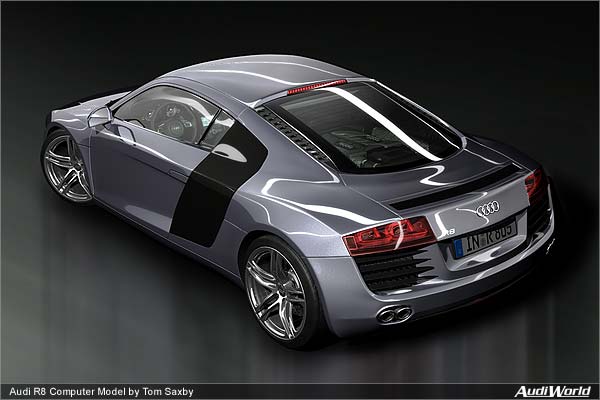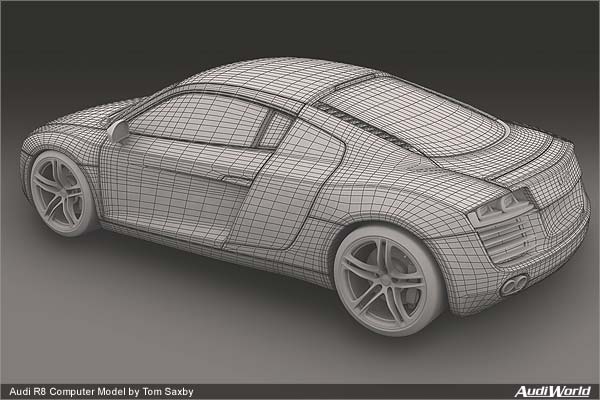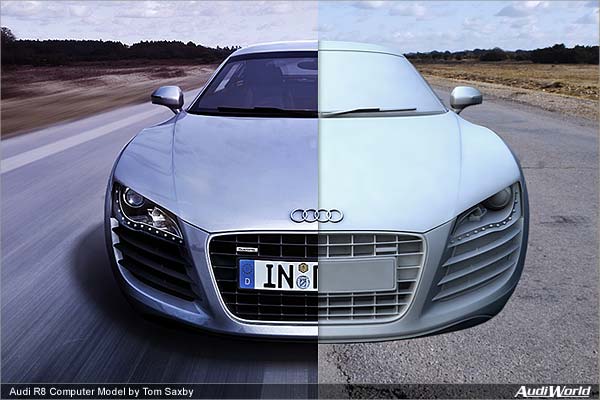CG Visualization: An Enthusiast Builds an Audi R8

Auto ads. We see them everywhere. Manufacturers glorifying their latest models, surrounding them with beautiful imagery all the while eager to sell you their dream. Have you ever wondered what the dreams in those ads are made of? The answer may surprise you; it’s not always metal, glass and rubber. A large proportion of contemporary car images in these ads are in fact computer generated. Sure, the backdrop of the perfect driving road or sensational cityscape is an actual photograph (or at leased based on one), but the star of the ad – the car – may well be a digital masquerade. A computer generated (CG) automobile can do whatever its creator wants it to. It can look wet, dry, black, silver or any color at the touch of a button. It will never show reflections from a cameraman, photographic equipment or the lighting crew. The vehicle can travel at over 100 mph down a straight and not get a speeding ticket, or drift around a treacherous bend without crashing. It can even reside within a spider’s web and prey on lesser-endowed cars. You have seen it done (or see the video link below if you have not). In short, car companies can do whatever they like when it comes to creative, emotional and inspiring campaigns. Auto ads have never looked better. What does it take to create these effects? It’s a combination of technical understanding and artistic intelligence. In some ways its the same ingredients that are required to be a top professional photographer, only the tools are much different. Like a Hollywood special effects team, an automotive artist will employ many different programs to produce the final product. What people probably do not realize is how time-consuming it is to produce an initial automobile model on the computer. A well-detailed computer model will often take hundreds of hours to create. The good news is that once a complete car model is finished is stands at the artist’s disposal, ready to maneuver into any visual scenario at the touch of a button. Imagine you’re the boss of the Audi Marketing Department and you have promotional stills of the new A6 travelling at stupendous speeds, but now you now want a shot of it diving underwater too? No problem, with the computer you can make it happen. You won’t even have to pay for wetsuits! The Digital Artist My name is Tom Saxby, and I’m the digital artist that created these images of the Audi R8. Why do I do this work? To put it simply it’s because I love the demand of different strands of traditional and cutting-edge techniques required to produce a high-quality finished product. I enjoy combining photography and artistic composition with computer modeling. I relish the sense of unconstrained creation that the computer allows. And most importantly, I love cars. What other series of products do we find such sensuous design detail? Metallic form and beauty may not appeal to all, but it can certainly be very pleasurable to the eye of the discerning automotive beholder.
As a kid I was mesmerized by the wonders of early computer graphics and made a decision to be a part of this business. After a couple of years studying architecture at university, I got a lucky break and started a job with a dynamic young company that specialized in retail advertising and in producing animated visualizations and stills for many large clients. At 21 I was heading up its creative team. Self-taught, but benefiting from working alongside experienced professionals, I was able to further my knowledge of not only technique and artistry, but also of the requisite marketing skills. Always looking for a challenge, I left the company five-years later to work as a specialist freelancer on a variety of projects. Currently, I am focusing on my favourite area of work – automotive visualization. When I create a piece I have many hopes and aspirations, but none is stronger than my hope that other people will genuinely enjoy my work. It gives me a great sense of pride being able to share my passion. The car I have most recently felt the most passionately about is the new Audi R8. It just oozes something awesome. Visualizing the Audi R8 Candidly, when I first saw the R8 I thought it was glorious, but nothing revolutionary. That said, the more I have looked at it, examined its detailing and traced its form, the more I have grown to respect and admire it. To use a cliché, like a fine wine sometimes we all need time to fully savor its delights – and I now find myself inebriated! It renders all other cars really rather, well, ordinary. The slickness of the R8 even makes a 911 begin to look frumpy. From whichever angle you look at the R8, it is simply sensational. Think about the R8 with its evocative grille ready to bite anything in its path, the eagle-like headlights, the swooping side-blades and the rapturous rear-end. Oh my gosh! This car is terrific and I feel like I’ve just got to have one – probably exactly what Audi wants me to think. Although there is not much chance of that in the short-term, I’m cheered by the fact that I can build one on my computer. The first step in the process was to get blueprints and lots and lots of photo references. AudiWorld turned out to be an excellent source for my research. Second, I needed to build the CG model of the car. Using Autodesk 3D Studio Max, I started with the body then moved onto the lights. Then came the wheels and I finished with the interior and engine bay. Up next was to look at materials. I needed to give my R8 some paint, make those tires look real and give the lights some well-deserved shine. Although this sounds straightforward, this is probably the most technical aspect of the project. Skills applied at this stage really show the difference between keen amateurs and a professional. Why? At this point getting it right requires not only computer science, but also a thorough comprehension of material science. For instance, what makes metal look the way it does? In what manner does tarmac reflect the light? The human eye is quick to tell the difference between computer generated and real. If something fails to ring true, the observer will instinctively know that something’s amiss even if the reason why is elusive. The next stage in the process is to actually leave the screen for the first time in a couple of weeks. But it’s been good investment. Now armed with a camera, I wanted to find a long straight bit of deserted road to provide a backdrop for the main image. I ended up right in the middle of some asphalt laid over an old World War II airfield. Standing in the middle of the tarmac, taking pictures of a bald road means getting funny looks from walkers, but to each their own.
Happy with a background image on which to composite the finished car (and still on location), I now proceed to take a High Dynamic Range Image (HDRI) capture. Compared to photos taken with a normal digital camera, an HDRI capture grabs a lot more light information. I take a 360-degree photo of the scene including the sky. Why? Well, modern 3D computer programs can take the sky’s light in the HDRI photo and use it to light up the CG automobile. The automobile is basically getting lit with the same photons as the backdrop. Invariably, as with all things digital, once back at the desk this will require further tweaking to get everything just right. Now with the artistic portion of the model completed, its time for the computer to do the hard number crunching and the final image is rendered. In simple terms, this means that the computer turns all the different visual inputs – surfaces, textures, lights, forms – into photorealistic imagery. This can take hours, sometimes even days, depending upon the complexity of the model and the scene’s lighting solution. Once the final render is done, the composition is layered together in a photo-editing program like Adobe Photoshop. The backdrop slides behind the car and final touch up is done – for example, white levels are tweaked, shadow areas are adjusted to reveal hidden detail, and photo filters are applied to add the desired color hues. Conclusion I got a great deal of satisfaction from this particular project. What I like most about this final R8 image is the sense of effortless speed that is achieved through computerized motion-blur of the road, which at the same time leaves the car in sharp detail. In addition, I chose to use a close wide-angle front shot of the R8 to exaggerate its inherent snarl. What a beast! As I said before, the greatest aspect of doing anything artistic is its potential to share a certain passion with others. I hope AudiWorld readers enjoy viewing the images of the Audi R8 that I have created. Although this particular Audi R8 was done for my personal portfolio and not for a client, it is a good example of the professional work that I create on a regular basis. In our Internet-based computer industry, you can work for anyone, anywhere in the world. If you’re interested in learning more about myself and my work, please contact me via my website below.
|


